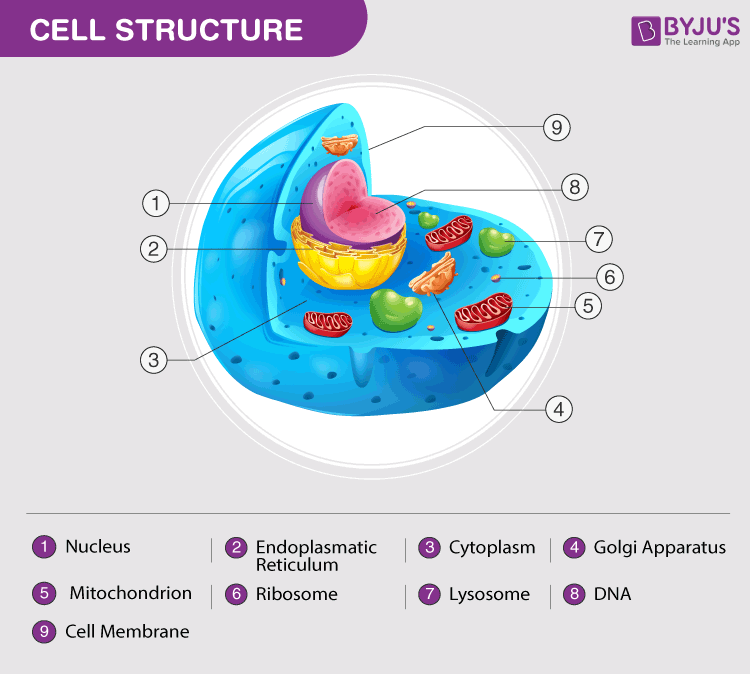Animal Cell Definition
“An animal cell is a type of eukaryotic cell that lacks a cell wall and has a true, membrane-bound nucleus along with other cellular organelles.”
“An animal cell is a type of eukaryotic cell that lacks a cell wall and has a true, membrane-bound nucleus along with other cellular organelles.”
Explanation
Animal cells range in size from a few microscopic microns to a few millimetres. The largest known animal cell is the ostrich egg, which can stretch over 5.1 inches across and weighs about 1.4 kilograms. This is in stark contrast to the neuron in the human body, which is just 100 microns across.
The shape of animal cells also varies, with some being flat, others oval or rod-shaped. There are also more intriguing shapes such as curved, spherical, concave and rectangular. Most of the cells are microscopic in size and can only be seen under the microscope.
As stated before, animal cells are eukaryotic cells with a membrane-bound nucleus. Furthermore, these cells exhibit the presence of DNA inside the nucleus. They also comprise other membrane-bound organelles and cellular structures which carry out specific functions necessary for a cell to function properly.
Animal cells range in size from a few microscopic microns to a few millimetres. The largest known animal cell is the ostrich egg, which can stretch over 5.1 inches across and weighs about 1.4 kilograms. This is in stark contrast to the neuron in the human body, which is just 100 microns across.
The shape of animal cells also varies, with some being flat, others oval or rod-shaped. There are also more intriguing shapes such as curved, spherical, concave and rectangular. Most of the cells are microscopic in size and can only be seen under the microscope.
As stated before, animal cells are eukaryotic cells with a membrane-bound nucleus. Furthermore, these cells exhibit the presence of DNA inside the nucleus. They also comprise other membrane-bound organelles and cellular structures which carry out specific functions necessary for a cell to function properly.
Animal Cell Diagram
The diagram given below depicts the structural organization of the animal cell. The various cell organelles present in an animal cell are clearly marked in the animal cell diagram provided below.

Animal cell diagram detailing the various organelles
Though this animal cell diagram is not representative of any one particular type of cell, it provides insight into the primary organelles and the intricate internal structure of most animal cells. Furthermore, it is easy to distinguish between a plant and animal cell diagram just by inspecting the presence or absence of a cell wall.
The diagram given below depicts the structural organization of the animal cell. The various cell organelles present in an animal cell are clearly marked in the animal cell diagram provided below.

Animal cell diagram detailing the various organelles
Though this animal cell diagram is not representative of any one particular type of cell, it provides insight into the primary organelles and the intricate internal structure of most animal cells. Furthermore, it is easy to distinguish between a plant and animal cell diagram just by inspecting the presence or absence of a cell wall.
Animal Cell Structure
Animal cells are generally smaller than plant cells. Another defining characteristic is its irregular shape. This is due to the absence of a cell wall. But animal cells share other cellular organelles with plant cells as both have evolved from eukaryotic cells.
A typical animal cell comprises the following cell organelles:
Animal cells are generally smaller than plant cells. Another defining characteristic is its irregular shape. This is due to the absence of a cell wall. But animal cells share other cellular organelles with plant cells as both have evolved from eukaryotic cells.
A typical animal cell comprises the following cell organelles:
Cell Membrane
A thin semipermeable membrane layer of lipids and proteins surrounding the cell. Its primary role is to protect the cell from its surrounding. Also, it controls the entry and exit of nutrients and other microscopic entities into the cell. For this reason, cell membranes are known as semi-permeable or selectively permeable membranes.
A thin semipermeable membrane layer of lipids and proteins surrounding the cell. Its primary role is to protect the cell from its surrounding. Also, it controls the entry and exit of nutrients and other microscopic entities into the cell. For this reason, cell membranes are known as semi-permeable or selectively permeable membranes.
Nucleus
It is an organelle that contains several other sub-organelles such as nucleolus, nucleosomes and chromatins. It also contains DNA and other genetic materials.
It is an organelle that contains several other sub-organelles such as nucleolus, nucleosomes and chromatins. It also contains DNA and other genetic materials.
Nuclear Membrane
It is a double-membrane structure that surrounds the nucleus. It is also referred to as the nuclear envelope.
It is a double-membrane structure that surrounds the nucleus. It is also referred to as the nuclear envelope.
Centrosome
It is a small organelle found near the nucleus, which has a thick centre with radiating tubules. The centrosomes are where microtubules are produced.
It is a small organelle found near the nucleus, which has a thick centre with radiating tubules. The centrosomes are where microtubules are produced.
Lysosome
They are round organelles surrounded by a membrane and comprising digestive enzymes which help in digestion, excretion and in the cell renewal process.
They are round organelles surrounded by a membrane and comprising digestive enzymes which help in digestion, excretion and in the cell renewal process.
Cytoplasm
A jelly-like material which contains all the cell organelles, enclosed within the cell membrane. The substance found within the cell nucleus, contained by the nuclear membrane is called the nucleoplasm.
A jelly-like material which contains all the cell organelles, enclosed within the cell membrane. The substance found within the cell nucleus, contained by the nuclear membrane is called the nucleoplasm.
Golgi Apparatus
A flat, smooth layered, sac-like organelle which is located near the nucleus and involved in manufacturing, storing, packing and transporting the particles throughout the cell.
A flat, smooth layered, sac-like organelle which is located near the nucleus and involved in manufacturing, storing, packing and transporting the particles throughout the cell.
Mitochondrion
They are spherical or rod-shaped organelles with a double membrane. They are the powerhouse of a cell as they play an important role in releasing energy.
They are spherical or rod-shaped organelles with a double membrane. They are the powerhouse of a cell as they play an important role in releasing energy.
Ribosome
They are small organelles made up of RNA-rich cytoplasmic granules, and they are the sites of protein synthesis.
They are small organelles made up of RNA-rich cytoplasmic granules, and they are the sites of protein synthesis.
Endoplasmic Reticulum (ER)
This cellular organelle is composed of a thin, winding network of membranous sacs originating from the nucleus.
This cellular organelle is composed of a thin, winding network of membranous sacs originating from the nucleus.
Vacuole
A membrane-bound organelle present inside a cell involved in maintaining shape and storing water, food, wastes, etc.
A membrane-bound organelle present inside a cell involved in maintaining shape and storing water, food, wastes, etc.
Nucleopore
They are tiny holes present in the nuclear membrane which are involved in the movement of nucleic acids and proteins across the nuclear membrane.
They are tiny holes present in the nuclear membrane which are involved in the movement of nucleic acids and proteins across the nuclear membrane.
Points to Note About Animal Cell
The cell is the structural and functional unit of life. These cells differ in their shapes, sizes and their structure as they have to fulfil specific functions. Plant cells and animal cells share some common features as both are eukaryotic cells.
However, they differ as animals need to adapt to a more active and non-sedentary lifestyle. Furthermore, animals need to acquire their own food, therefore, they do not possess any of the specialized cell organelles such as chloroplasts.
The cell is the structural and functional unit of life. These cells differ in their shapes, sizes and their structure as they have to fulfil specific functions. Plant cells and animal cells share some common features as both are eukaryotic cells.
However, they differ as animals need to adapt to a more active and non-sedentary lifestyle. Furthermore, animals need to acquire their own food, therefore, they do not possess any of the specialized cell organelles such as chloroplasts.








0 Comments